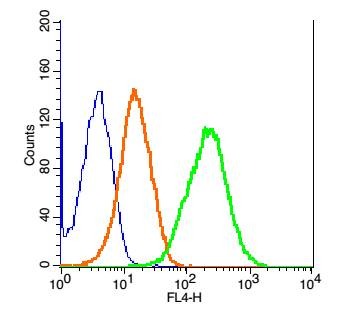Shopping Cart
Remove All Your shopping cart is currently empty
Your shopping cart is currently empty
Anti-Aquaporin-9/AQP9 Polyclonal Antibody is a Rabbit antibody targeting Aquaporin-9/AQP9. Anti-Aquaporin-9/AQP9 Polyclonal Antibody can be used in FCM.
| Pack Size | Price | USA Warehouse | Global Warehouse | Quantity |
|---|---|---|---|---|
| 50 μL | $221 | 7-10 days | 7-10 days | |
| 100 μL | $373 | 7-10 days | 7-10 days | |
| 200 μL | $527 | 7-10 days | 7-10 days |
| Description | Anti-Aquaporin-9/AQP9 Polyclonal Antibody is a Rabbit antibody targeting Aquaporin-9/AQP9. Anti-Aquaporin-9/AQP9 Polyclonal Antibody can be used in FCM. |
| Synonyms | SSC1, SSC 1, Small solute channel 1, HsT17287, HsT 17287, Aquaporin9, aquaporin Protein-9, Aquaporin 9, Aquaglyceroporin-9, AQP-9, AQP9, AQP 9 |
| Ig Type | IgG |
| Reactivity | Human (predicted:Mouse,Rat,Dog,Pig,Cow,Rabbit,Sheep,GuineaPig) |
| Verified Activity | Blank control: A549 (blue). Primary Antibody: Rabbit Anti-AQP9/AF647 Conjugated antibody (TMAB-00143/AF647), Dilution: 1 μg in 100 μL 1X PBS containing 0.5% BSA; Isotype Control Antibody: Rabbit IgG/AF647 (orange),used under the same conditions. Protocol The cells were fixed with 2% paraformaldehyde (10 min). The cells were washed twice with 1 X PBS. The cells were incubated in 1 X PBS containing 0.5% BSA + 10% goat serum (15 min) to block non-specific protein-protein interactions followed by the incubated with antibody (TMAB-00143/AF647, 1 μg/1x10^6 cells) for 30 min on ice.  |
| Application | |
| Recommended Dose | FCM: 1μg /test |
| Antibody Type | Polyclonal |
| Host Species | Rabbit |
| Subcellular Localization | Membrane; Multi-pass membrane protein. |
| Tissue Specificity | Highly expressed in peripheral leukocytes. Also expressed in liver, lung, and spleen. |
| Construction | Polyclonal Antibody |
| Purification | Protein A purified |
| Appearance | Liquid |
| Formulation | 0.01M TBS (pH7.4) with 1% BSA, 0.02% Proclin300 and 50% Glycerol. |
| Concentration | 1 mg/mL |
| Research Background | Water is a critical component of all living cells. Interestingly, tissue membranes show a great degree of water permeability. Mammalian red cells, renal proximal tubules, and descending thin limb of Henle are extraordinarily permeable to water. Water crosses hydrophobic plasma membranes either by simple diffusion or through a facilitative transport mechanism mediated by special protein "aquaporin". A new member of AQP family, Aquaporin-9 (AQP9), has been cloned from human leukocytes by homology cloning (Ishibashi et al. 1997). It is mostly homologous with AQP3 and AQP7 (54-48% identity). AQP9 (295 AA) is primarily expressed in peripheral leukocytes, and lesser amounts in liver, lung and spleen. AQP9 is permeable to water and urea. Unlike AQP3 and AQP7, it did not facilitate glycerol transport. AQP families of proteins are predicted to contain six transmembrane domains. The N and C-terminus are predicted to be cytoplasmic. A new member of the AQP family, AQP9, has been cloned from human leukocytes. It is homologous with AQP3 and AQP7 (54-48% identity). AQP9 (295aa) is primarily expressed in peripheral leukocytes, and in lesser amounts in liver, lung and spleen. AQP9 is permeable to water and urea. Unlike AQP3 and AQP7, it does not facilitate glycerol transport. AQP families of proteins are predicted to contain six transmembrane domains. The N and C-terminus are predicted to be cytoplasmic. |
| Immunogen | KLH conjugated synthetic peptide: human AQP9 |
| Antigen Species | Human |
| Gene Name | AQP9 |
| Gene ID | |
| Protein Name | Aquaporin-9 |
| Uniprot ID | |
| Biology Area | Cancer,Channels |
| Function | Forms a channel with a broad specificity. Mediates passage of a wide variety of non-charged solutes including carbamides, polyols, purines, and pyrimidines in a phloretin- and mercury-sensitive manner, whereas amino acids, cyclic sugars, Na(+), K(+), Cl(-), and deprotonated monocarboxylates are excluded. Also permeable to urea and glycerol. |
| Molecular Weight | Theoretical: 32 kDa. |
| Stability & Storage | Store at -20°C or -80°C for 12 months. Avoid repeated freeze-thaw cycles. |
| Transport | Shipping with blue ice. |
| Size | Quantity | Unit Price | Amount | Operation |
|---|

Copyright © 2015-2025 TargetMol Chemicals Inc. All Rights Reserved.